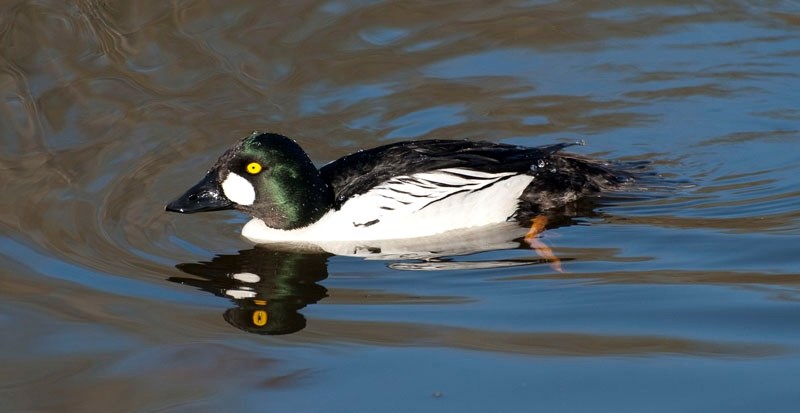I've been photographing birds for a number of years, and the one I find the most enticing is the common goldeneye. I saw scores of them on Big Lake last April during the start of the spring melt.
I've been photographing birds for a number of years, and the one I find the most enticing is the common goldeneye.
I saw scores of them on Big Lake last April during the start of the spring melt. The whole patch of open water was crammed with them, and many were throwing their heads back for no apparent reason. Yet now I'm lucky if I even see one.
Where did they all go?
They're still here, birder Ludo Bogaert tells me – I'm just looking in the wrong place.
"They nest in hollow trees," he says, so most of them are hidden in the forest right now.
Many will have moved further north to breed in the boreal forest or ditched their wives to hang out in migratory staging grounds like Cardinal Lake, adds Jonathan Thompson, a senior wildlife biologist with Golder Associates who's spent years studying goldeneyes.
The male common goldeneye is a black and white duck with an iridescent head and brilliant, golden yellow eyes. They also have two big white circles near the bridge of their bill.
"It gives them the appearance of having spectacles," Bogaert says.
Females have chocolate brown heads, grey backs and wings and white bellies.
Listen, adds Thompson, and you will hear their wings make a distinct whistling sound as they fly. Goldeneyes used to be called "whistlers" for this reason.
The Barrow's goldeneye looks very similar to the common, say Bogaert and Thompson, but almost never comes to St. Albert as it favours mountainous regions. The male Barrow's goldeneye will have white crescents instead of circles near its bill, while the females will be darker brown.
Common goldeneyes are very early migrants, Bogaert says, and are often the first birds to show up once the ice recedes. The head-tossing I saw on Big Lake was part of their mating ritual, where males throw their heads back, point their bills skyward, and kick water with their feet to impress the ladies. When they're not mating, goldeneyes will dive underwater in search of bugs and snails on the riverbed.
Territorial terrors
Unlike many water birds, Thompson says, goldeneyes will aggressively defend a specific patch of water during mating – you can almost draw a fence around it. Goldeneyes lay very large eggs and need a lot of food, he explains, so they will pick a food-heavy spot on a lake or river and defend it.
This explains the behaviour of an ornery lady goldeneye I saw at Grandin Pond a few years ago – one that spent all her time swimming around, charging at coots and mallards, and even diving below the surface so she could nip at their bums from below.
Goldeneyes nest in trees or nest boxes, often in holes left by pileated woodpeckers.
This is far safer than nesting on the ground, says Thompson. Goldeneye eggs have a roughly 40 to 70 per cent survival rate, he notes, compared to just 10 to 15 per cent for ground-nested mallard eggs.
But since there aren't that many empty woodpecker holes around, goldeneyes are often short on real estate. Females who can't find a good hole or box will often lay their eggs in another lady's nest instead, Thompson says, giving her up to 20 foster kids to raise.
But hold off on those mom-of-the-year awards: one of the first things mama goldeneye does post-hatch is to have her kids jump out a window.
The mom will first leave the nest and call her kids from the ground, Johnson says. After hopping up and down "like popcorn" to reach the edge of the hole, the chicks will leap to their apparent doom, flapping their useless wings as they do so. Instead of going splat, "they just bounce, almost like a tennis ball," due to their light weight and dense down.
The chicks are all right unless they hit something on the way down, Johnson says.
"It's amazing the height some of them can jump from and not incur any injury," he says. He's seen drops of about nine metres.
Look closely at these chicks, the Cornell Lab of Ornithology notes, and you'll see that their eyes are not gold. Goldeneye eyes start out grey-brown and then turn purple-blue, blue, green-blue and clear pale yellow-green before becoming golden yellow as adults.
And they vary seasonally after that, Johnson notes. A goldeneye's eyes reach peak gold during breeding and fade after moulting.
Goldeneyes should return en masse to Big Lake during the fall migration, Johnson says.
I, for one, will be keeping an eye out for them.
Common goldeneye
Name:
Bucephala clangula.
Appearance:
Chunky diving ducks. Males are black and white with white "glasses" on bridge of bill. Females have brown head and grey body. Both ducks have piercing yellow eyes.
Commonly seen:
Diving for food, throwing their heads back to impress ladies.
Occasionally confused with:
The Barrow's goldeneye, which has crescent shapes near its bill instead of white circles. Females are very tough to tell apart.
Fun fact:
When two opposing parents fight, their young ducklings often get mixed up and hook up with the wrong mom afterwards.
Wild St. Albert
Like wildlife? So do we! Every second Wednesday the Gazette profiles a reasonably common wild creature in the St. Albert region. Birds, beasts, bugs, fish … so long as it's alive and kicking, we'll feature it. <br /><br />Got a creature you'd like to see profiled? Send your suggestions to [email protected].




